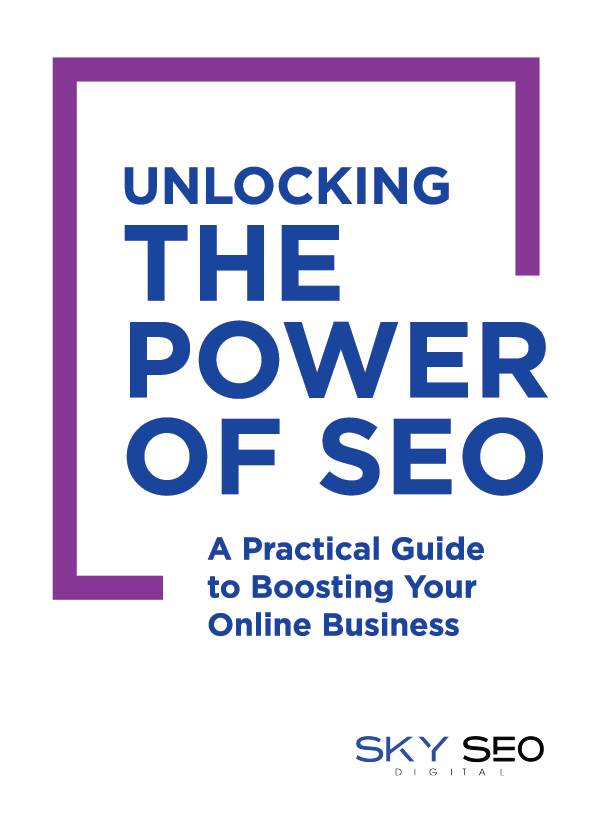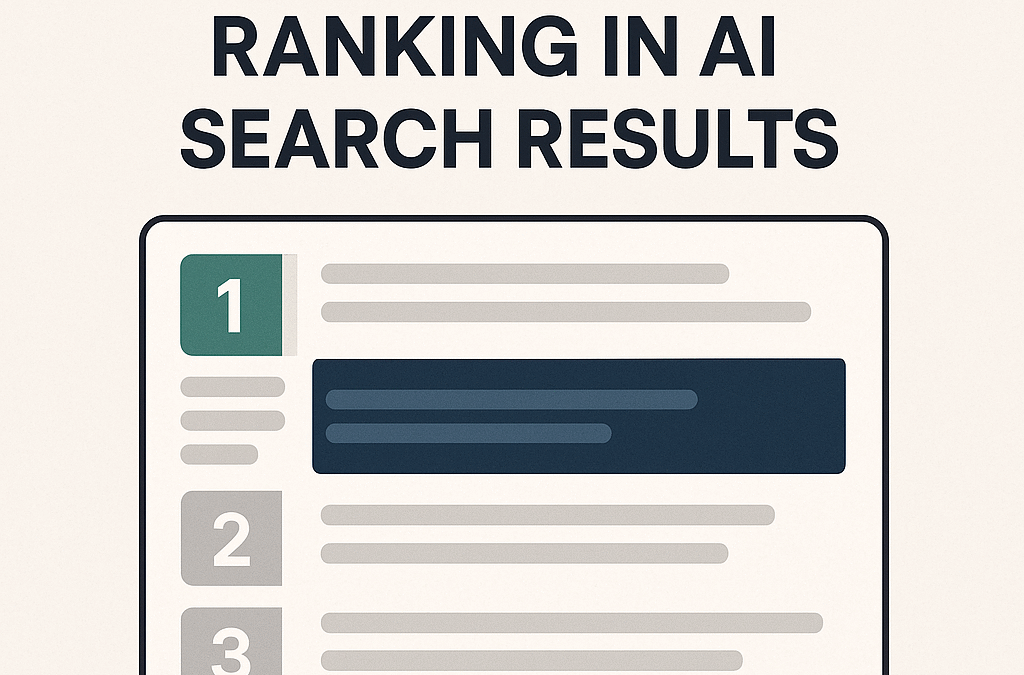From AI and AR revolutionizing the way we interact with online content, to the increasing importance of local SEO and mobile optimization, the landscape of SEO in 2024 will be dynamic, multi-faceted, and exciting. It’s clear that to stay competitive in this environment, businesses and SEO professionals must be willing to adapt and innovate, embracing new trends while maintaining a strong foundation in established SEO best practices.
In this comprehensive guide, we delve into the key SEO trends and considerations for 2024, providing insights and actionable strategies to help you navigate the ever-evolving digital landscape. We’ll explore topics such as the increasing role of AI in SEO, the shift towards more engaging and quality content, the critical role of page speed, the impact of AR on user experience, the evergreen importance of backlinks, and the advent of generative AI in search.
AI in SEO
Artificial Intelligence (AI) will become a core part of the SEO landscape in 2024, refining and improving how search engines deliver results and how businesses optimize their online presence.
The Emergence of AI
AI was primarily used by search engines to improve their algorithms initially. Over time, it started to drive other aspects of SEO, too, such as content creation, user experience, and even link building. One example of AI’s impact is Google’s use of its AI algorithm, RankBrain, which interprets the context and intent behind search queries, even ones it’s never seen before.
Role of AI in Understanding User Intent
AI plays a crucial role in understanding user intent in search queries. It aids search engines in interpreting the underlying goal or reason behind a user’s search. For example, if a user searches for ‘pizza near me,’ AI understands that the user is probably looking for pizza delivery or a pizza restaurant in their area. This level of understanding is significant for businesses because it allows them to tailor their SEO strategies to match user intent and not just keywords.
Personalized User Experiences
AI also plays a key role in providing personalized user experiences. By understanding user behavior, interests, and patterns, AI can help businesses offer personalized content, product recommendations, and more. An e-commerce store, for instance, can use AI to recommend products based on a user’s browsing history or previous purchases, enhancing the user experience and increasing the likelihood of a sale.
Content Optimization
AI has become a game-changer in content optimization, helping businesses create high-quality, relevant content that resonates with their audience and ranks well on search engines. Tools like Frase or MarketMuse use AI to analyze top-ranking content and provide insights on topics and subtopics to cover, ensuring comprehensive content that answers user queries.
AI and Link Building
Even link building, a core aspect of SEO, has been influenced by AI. Tools like SEO PowerSuite’s LinkAssistant use AI to find high-quality link building opportunities based on factors like relevance, authority, and more.
Future of AI in SEO
Looking towards the future, we can expect AI to become even more integral to SEO. Advances in AI technology will allow for more accurate interpretation of user intent, more personalized user experiences, and more effective content strategies.
However, as AI becomes more sophisticated, it’s crucial for businesses to keep up. This means continuously learning about new AI technologies and how they can be applied to SEO, staying informed about changes to search engine algorithms, and being ready to adapt their strategies as needed.
Content Writing for SEO
As SEO evolves, the quality, relevance, and utility of content become increasingly important. From the length and tone of the articles to topic selection and optimization, every element plays a part in the performance of the content on search engines.
Article Length
The ideal article length for SEO is a topic of much debate among SEO professionals. Generally, comprehensive and in-depth content tends to perform better, as it typically provides more value to readers. In the era of AI and user-intent search, articles that offer thorough coverage of a topic, often ranging from 1,000 to 2,500 words, tend to perform well. For example, a blog post titled “The Complete Guide to Gardening for Beginners” that covers everything a novice gardener needs to know might outperform shorter, less detailed content.
However, it’s crucial to remember that the content’s length should be dictated by the audience’s needs and the topic at hand. An article should be as long as it needs to be to provide value and answer the user’s query fully and succinctly.
Tone
The tone of an article can significantly impact user engagement. Content that aligns with the audience’s preferences can help build trust, increase time spent on the page, and improve conversions. For instance, a technical blog aimed at IT professionals may have a formal, informative tone, while a travel blog for backpackers might adopt a casual, friendly tone. AI tools like Grammarly Tone Detector can help gauge the tone of your content and ensure it aligns with your target audience.
How to Choose a Topic
Choosing the right topic is crucial to attract relevant traffic. A few strategies include:
- Understand Your Audience: Who are you writing for? What are their interests, questions, or problems that your content can address?
- Keyword Research: Use SEO tools like SEMrush, Ahrefs, or Google Keyword Planner to identify popular keywords in your niche.
- Competitor Analysis: Look at what topics your competitors are covering. Can you provide a new perspective or go more in-depth?
- Current Trends: Stay updated with industry trends or news. Tools like Google Trends or BuzzSumo can provide insights on popular topics.
- User Feedback: Pay attention to comments or questions from your audience. They can offer invaluable insights into potential topics.
How to Optimize Content
Optimizing your content involves making it easy for search engines to understand and rank. Key factors include:
- Keyword Optimization: Include your target keywords naturally in your content, title, headings, URL, and meta description.
- User Experience: Make your content easy to read and understand. Break it up with headings, bullet points, and images.
- Internal and External Links: Link to relevant internal and external content. This helps search engines understand the context of your content.
- Mobile Optimization: Ensure your content is readable and navigable on mobile devices.
- Meta Descriptions and Title Tags: These should be enticing and include your main keyword to increase click-through rates from search engine results pages.
In summary, content writing for SEO in 2024 will be about understanding your audience and providing them with valuable, optimized content. It’s a balance between the technical aspects of SEO and the art of engaging, valuable writing.
Importance of Page Speed in SEO
Page speed, or the time it takes for a web page to load, plays a pivotal role in user experience and SEO. As search engines aim to provide users with the best possible results, they favor websites that offer fast, efficient experiences.
Why Page Speed Matters
Page speed is crucial for two main reasons: user experience and search engine ranking. Slow loading times can frustrate users, leading to higher bounce rates, lower engagement, and reduced conversions. From an SEO perspective, search engines consider page speed as a ranking factor. Slow-loading pages are likely to rank lower, leading to decreased visibility and organic traffic.
Image Types and Page Speed
Images can significantly affect page speed. They often account for most of the data used on a page, so optimizing them can lead to substantial improvements in load time. Several image formats are optimized for the web:
- JPEG: This format is suitable for photographs or images with many colors. It provides a good balance between image quality and file size.
- PNG: PNGs are ideal for images that require transparency, like logos. However, they tend to have larger file sizes than JPEGs.
- WebP: WebP is a modern format that provides superior compression and quality characteristics compared to JPEG and PNG. It can help reduce file size without compromising on quality.
- SVG: For vector images like logos or icons, SVG is the best format. SVGs are scalable without loss of quality and typically have smaller file sizes.
CSS and JavaScript’s Impact on Page Speed
CSS and JavaScript files can significantly impact page speed. Larger files and inefficient code can slow down a website, so it’s crucial to optimize these elements:
- Minification: This process removes unnecessary characters (like spaces and comments) from the code, reducing its size.
- Compression: Gzip compression can reduce the size of CSS, JavaScript, and HTML files sent from your server.
- Eliminate Render-Blocking Resources: CSS and JavaScript files can block the page from rendering promptly. Techniques like “defer” and “async” can be used to control how these files load and prevent them from slowing down the page.
Checking Page Speed
Several tools can help assess and improve page speed:
- Google’s PageSpeed Insights: This tool provides a performance score for both mobile and desktop, along with suggestions for improvement.
- GTmetrix: GTmetrix offers a comprehensive analysis of your site’s speed performance and gives specific recommendations.
- WebPageTest: This tool provides detailed information about your site’s load time, including a waterfall view of requests.
- Lighthouse: Integrated into Chrome’s DevTools, Lighthouse generates an overall performance score and practical tips for enhancing page speed.
By optimizing images, refining CSS and JavaScript files, and regularly monitoring page speed, websites can provide a better user experience, improve their SEO, and ultimately, increase their chances of online success.
Augmented Reality (AR) and SEO
As technology evolves, so does the landscape of SEO. One of the most significant advancements in recent years is Augmented Reality (AR). AR overlays digital information onto the real world, providing a composite view to the user. It has begun to influence SEO strategies by creating unique user experiences and affecting search behavior.
AR vs VR
Before we dive into the impact of AR on SEO, it’s important to differentiate AR from Virtual Reality (VR). AR enhances the real world with digital information, like Snapchat filters or the Pokemon Go game, while VR creates a completely digital, immersive environment, like Oculus Rift. The key difference lies in the level of immersion and interaction with the real world. While AR enhances our interaction with the real world, VR creates a completely new world.
Impact of AR on SEO
The primary way AR affects SEO is through the creation of interactive experiences that encourage user engagement. This can lead to more time spent on a website or app, more social shares, and more inbound links, all of which are positive signals for search engine ranking algorithms. For example, a furniture retailer could use AR to allow customers to visualize how different products would look in their homes. This kind of interactive content could lead to increased engagement, repeat visits, and more backlinks as other sites link to the innovative feature.
AR and Local SEO
AR can also have significant impacts on local SEO. Mobile AR applications can provide users with location-specific information, creating opportunities for businesses to attract nearby customers. For example, an AR app might show users nearby restaurants, along with ratings and reviews, when pointed down a street. As such, businesses will need to ensure their local SEO strategies are robust, with up-to-date, accurate information on platforms like Google My Business.
The Future of AR and SEO
As AR technology becomes more widespread, we can expect it to play an increasingly significant role in SEO. Businesses will need to think creatively about how they can incorporate AR into their digital strategies, both to provide engaging experiences for their customers and to stay ahead in search engine rankings.
Backlinks and SEO
Backlinks remain a critical component of SEO in 2024, signifying a vote of confidence from one site to another. When one website links to another, it sends a signal to search engines that the content is valuable and trustworthy.
The Importance of Quality Backlinks
Quality, authoritative backlinks can significantly improve a website’s search engine rankings. They help to increase the website’s authority and trustworthiness in the eyes of search engines, leading to improved rankings. For example, a backlink from a reputable news site like the New York Times can have a substantial positive impact on SEO.
However, it’s crucial to remember that not all backlinks are created equal. Quality matters more than quantity, and spammy or toxic links can hurt your SEO.
Toxic or Spammy Links
Toxic or spammy links are links from low-quality, untrustworthy, or irrelevant sites. These can harm your site’s ranking, as search engines may perceive your site as being associated with these negative qualities. For example, a link from a spam-filled comments section or a link purchased from a link farm can be considered toxic.
Google’s Penguin algorithm update was specifically designed to penalize sites with unnatural backlink profiles, including those with excessive spammy or purchased links. Therefore, it’s essential to regularly audit your backlink profile to identify and disavow toxic links.
Competitor Research
Competitor backlink research is a valuable strategy in building a robust backlink profile. By analyzing the backlink profiles of competing websites, you can uncover opportunities for your own link-building efforts.
For instance, if a competitor has a backlink from a high-authority industry blog, you could reach out to that blog and offer a guest post. This can help you not only gain a quality backlink but also increase your visibility and reputation in your industry.
Tools for Link Audits
Several tools can help you conduct a comprehensive link audit:
- SEMrush: SEMrush’s Backlink Analytics tool lets you analyze your backlink profile and your competitors’. It also offers a Backlink Audit tool that identifies potentially toxic links.
- Ahrefs: Ahrefs provides an in-depth look at your backlink profile, including the number of backlinks, the domains they come from, and their quality. It also flags potentially harmful links.
- Moz’s Link Explorer: This tool provides an overview of your backlink profile and domain authority, and identifies new link-building opportunities.
- Google Search Console: GSC allows you to download a list of links to your site, which you can analyze to identify any toxic or spammy backlinks.
While backlinks remain an important part of SEO, it’s the quality of those links that truly matters. Regular audits, disavowing harmful links, and capitalizing on opportunities discovered through competitor research are all essential parts of maintaining a strong backlink profile.
Generative AI and Its Effect on Search
Generative AI, a subset of artificial intelligence, has significantly transformed the digital landscape, including search engine operations and SEO strategies. This technology uses machine learning algorithms to create new content or data that mirrors the input data it has been trained on.
Generative AI and Search Engines
Search engines like Google have started employing AI and machine learning technologies to improve their search results. Google’s AI algorithm, RankBrain, interprets search queries and provides the best matching results, enhancing search accuracy.
With advancements in generative AI, search engines may soon be able to generate more personalized, context-aware search results. For example, if a user searches for “best Italian restaurants,” the search engine could consider the user’s location, past search history, and preferences to generate a custom list of Italian restaurants. This level of personalization could redefine SEO, making it crucial for businesses to understand their audience deeply and cater to their specific needs.
Generative AI in SEO Strategies
Generative AI has found its place in SEO strategies as well. AI-powered tools can generate content, perform keyword research, optimize metadata, and predict SEO trends. For instance, a tool like Phrasee uses generative AI to create high-performing email subject lines, increasing open rates and conversions.
Moreover, generative AI can be utilized to produce SEO-friendly content based on specific keywords or topics. Tools like Jasper (formerly Jarvis) and ChatGPT by OpenAI can generate blog posts, product descriptions, meta descriptions, and more, all optimized for SEO.
The Future of Generative AI in Search
As generative AI evolves, so will its impact on search and SEO. We could see more advanced personalization in search results, AI-generated content becoming more mainstream, and SEO strategies becoming more data-driven and predictive.
However, the increasing use of AI also brings ethical and practical considerations. For example, businesses and SEO professionals need to ensure that AI-generated content provides genuine value to users and doesn’t result in low-quality, irrelevant, or misleading content.
Furthermore, with AI possibly creating more personalized search results, privacy concerns may arise. The use of personal data in search could lead to debates about the extent to which personalization should be used and how to protect users’ privacy in the process.
Web Design and SEO
Web design and SEO are inherently intertwined. The way a website is designed can significantly impact its search engine rankings. A well-designed, user-friendly website can improve visibility, attract more visitors, and increase conversions.
Importance of Responsive Design
Responsive design is a web design approach that makes your website look good on all devices, whether it’s a desktop, tablet, or mobile phone. With the rise of mobile browsing, responsive design has become critical for SEO.
Google uses mobile-first indexing, meaning it primarily uses the mobile version of a site’s content for indexing and ranking. As a result, websites that are not mobile-friendly may suffer in search engine rankings.
Moreover, a responsive design improves user experience, which is another important ranking factor. If a visitor finds your site hard to navigate or the layout unappealing, they’re more likely to bounce back to the search results, which can negatively affect your SEO.
Mobile Browsing and SEO
The rise of smartphones has made mobile browsing the norm. More than half of all web traffic now comes from mobile devices. This shift in browsing habits has profound implications for SEO.
For one, it means that websites must be optimized for mobile users. This goes beyond just having a responsive design. It includes considerations like:
- Speed: Mobile users often have slower internet connections than desktop users, so mobile sites must be optimized for speed. This means compressing images, minifying CSS and JavaScript, and leveraging browser caching.
- Ease of Use: Mobile screens are smaller, so buttons and links must be large enough to tap, and text must be large enough to read without zooming.
- Local SEO: Mobile users often perform local searches, like “restaurants near me.” Therefore, local SEO strategies are crucial for businesses that want to attract mobile users.
Web Design Best Practices for SEO
Incorporating SEO considerations into web design can lead to more organic traffic and better rankings. Here are some best practices:
- Navigation: A clear and intuitive navigation structure can help both users and search engine crawlers. It can improve user experience and make it easier for search engines to index your site.
- Internal Linking: Proper internal linking guides users to other relevant sections of your site, increasing dwell time. It also helps search engines understand the structure and content of your site.
- Use of Multimedia: Images, videos, infographics, and other media can improve user engagement. However, these should be optimized (for example, by compressing images and using relevant alt text) to prevent slow load times.
By integrating SEO considerations into web design, you can create a website that is not only aesthetically pleasing and user-friendly but also highly visible to search engines.
Local SEO in 2024
Local SEO will remain a crucial component of a successful digital marketing strategy in 2024, particularly for businesses that operate in specific geographic areas. By optimizing your website and online presence for local search, you can attract more business from relevant local searches.
The Importance of Local SEO
With the continued growth of mobile search and the prominence of ‘near me’ queries, Local SEO has gained more traction. Google’s algorithm has become increasingly sophisticated at understanding the local intent behind queries, meaning a search for “pizza” will likely yield results for pizza places in the user’s local area.
For small businesses, Local SEO can level the playing field, allowing them to compete against larger, national brands. Local search users are often further down the sales funnel, with a higher intent to purchase, which can lead to increased conversions.
Key Local SEO Strategies in 2024
Here are the key strategies for succeeding with Local SEO in 2024:
- Google My Business (GMB) Optimization: Your GMB listing is often the first thing a potential customer sees when they search for your business. Ensure your listing is claimed, fully completed, and regularly updated.
- Online Reviews: Online reviews not only influence customer decision-making but also impact local search rankings. Encourage happy customers to leave reviews, and respond promptly and professionally to negative reviews.
- Local Business Citations: Ensuring your business information is accurate and consistent across online directories can boost your local SEO.
- Local Link Building: Links from other local businesses, community websites, or local news sources can strengthen your local SEO.
- Localized Content: Creating content that is relevant to your local audience can improve your visibility in local search results.
The Role of AI and AR in Local SEO
Technological advancements, like AI and Augmented Reality (AR), also have a bearing on Local SEO. AI’s capability to provide personalized search results means businesses need to thoroughly understand their local audience’s preferences and needs.
AR offers new ways to engage local customers. For instance, local businesses can offer AR experiences that allow customers to visualize products or services in their environment, encouraging more in-store visits or purchases.
The Future of Local SEO
Local SEO will continue to be a critical strategy for businesses as search engines strive to provide increasingly personalized results. Future trends might include even more personalization, with search results tailored to individual users based on their search history, preferences, and real-time context.
Content Strategy for SEO in 2024
Effective content will remain a cornerstone of SEO in 2024. However, the focus has shifted from quantity to quality, with an emphasis on creating content that is valuable, engaging, and optimized for both search engines and users. Here, we delve into the critical factors of content length, tone, topic selection, and optimization.
Content Length
When it comes to content length, there isn’t a one-size-fits-all approach. The ideal length depends on various factors, including the purpose of the content, the audience, and the topic. Comprehensive, in-depth articles may require a higher word count, while concise, to-the-point articles may be shorter.
That said, studies have shown a correlation between longer content and higher rankings. This doesn’t mean you should inflate your content unnecessarily, but rather ensure it provides thorough, in-depth coverage of your topic. If that means your blog post ends up being 2,000 words long, so be it.
Tone of Content
The tone of your content should match your brand voice and be appropriate for your audience and the content’s purpose. A casual, conversational tone may work well for a lifestyle blog, while a more formal tone might be suitable for a corporate report.
Additionally, Google’s algorithm has become increasingly adept at understanding natural language. This means writing in a way that sounds human – not just stuffing keywords into your content – can help your SEO.
Topic Selection
Choosing the right topics is crucial for SEO. Your content should be relevant to your industry and valuable to your audience. There are several strategies for finding good topics, such as:
- Keyword research: Use tools like Google Keyword Planner, SEMrush, or Ahrefs to find keywords relevant to your business. These can provide topic ideas.
- Competitor analysis: Look at what topics your competitors are covering. Can you provide a new perspective or more in-depth coverage?
- Audience feedback: Listen to your audience. What questions are they asking? What problems do they need solutions for?
Content Optimization
Once you’ve created your content, it’s time to optimize it for SEO. This includes:
- Keyword usage: Use your target keywords in strategic places like the title, headings, and throughout the content. But remember, don’t keyword stuff!
- Meta tags: Write compelling meta titles and descriptions with your target keyword to increase click-through rates from search results.
- Internal and external links: Include links to relevant content on your site and reputable external sources. This can help search engines understand the content and context of your page.
- Image optimization: If you’re using images, make sure they’re optimized with appropriate file names and alt tags.
In summary, creating quality content that is valuable to your audience and optimized for search engines is key to successful SEO in 2024.
Embracing the Future of SEO
As we’ve explored, the trends shaping SEO—from AI and AR to content creation, page speed, backlinks, local SEO, and more—are all aimed at enhancing user experience and creating meaningful engagements.
Remember, at its core, SEO is about providing value to your audience. As technology evolves and trends shift, this central tenet remains. It’s not about gaming the system, but about understanding your audience’s needs and meeting them with high-quality, relevant, and accessible content.
By staying informed and adaptable, leveraging new technologies, and maintaining a user-centric approach, you can position your website not only to rank well in search engine results but also to resonate with your audience in a deep and lasting way. Here’s to embracing the dynamic, ever-evolving landscape of SEO in 2024 and beyond!









